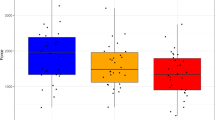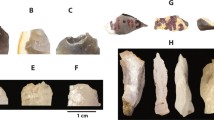Abstract
Flaked stone tools are the most durable and therefore the most common artifacts available to archaeologists for tracing the development of early Man. However, the essential mechanics of conchoidal flake formation has not yet been described. In order to successfully create a relatively thin flake that does not terminate prematurely, the direction of the flaking force has to be reasonably precise. We show that the direction of the flaking force is determined mainly by the stiffness of the flake, the actual angle of the blow or impulse having relatively little effect. Long thin flakes can be easily produced because this direction of the flaking force is very close to that necessary to produce local symmetry at the tip of the crack propagating parallel to the surface of the stone.
Résumé
Les outils en pierre taillée sont les témoignages les plus durables et, dès lors, les plus courants à disposition des archéologues pour traquer le développement des premiers hommes. On n'a cependant pas encore décrit les mécanismes essentiels de la formation d'une écaille conchoïdale. Pour créer avec succès une écaille relativement mince qui ne soit pas prématurément trop courte, il faut que le direction de la force d'écaillage soit relativement précise. On démontre que la direction de cette force est essentiellement déterminée par la raideur de l'écaille, l'angle réel de percussion ayant, pour sa part, un effet relativement peu important. Il est possible de réaliser des écailles longues et minces dès lors que la direction de la force d'écaillage est très voisine de celle nécessaire à produire une symétrie locale à l'extrémité d'une fissure se propageant parallèlement à la surface de la pierre.
Similar content being viewed by others
References
B. Lawn and R. Wilshaw, Journal of Materials Science 10 (1975) 1049–81.
A. Faulkner, Mechanical Principles of Flintworking, Doctoral dissertation, Washington State University (1972).
F. von Kerkhof and H. Müller-Beck, Glastechnische Berichte 42 (1969) 439–48.
J.G. Fonseca, J.D. Eshelby and C. Atkinson, International Journal of Fracture Mechanics 7 (1971) 435–47.
B. Cotterell and J. Kamminga, in Lithic Use-Wear Analysis, B. Hayden, Editor, Academic Press (1979) 97–112.
J. Kamminga, Over the Edge, Functional Analysis of Australian Stone Tools, Occasional Papers of Anthropology, Anthropology Museum, University of Queensland, 12 (1982).
L.H. Keeley, Experimental Determination of Stone Tool Uses, University of Chicago Press (1980).
B. Gross and J.E. Srawley, Stress-Intensity Factors by Boundary Collocation for Single Edge-Notch Specimens Subject to Splitting Forces, NASA TN-D3295 (1966).
M.J. Fernandes, Determination of the Stress Intensity Factors, and the First Three Non-Zero Matrix Coefficients for the Compact Tension Specimen Subjected to Mode I and Mode II Crack Tip Loading, Master of Engineering Science thesis, Sydney University (1977).
R.M.L. Foote and V.T. Buchwald, International Journal of Fracture 39 (1985).
M.L. Williams Journal of Applied Mechanics 24 (1957) 109–14.
F. Erdogan and G.C. Sih, Journal of Basic Engineering 85 (1963) 519–27.
I. Finnie and A. Saich, International Journal of Fracture 9 (1973) RCR 484–6.
P.D. Ewing and J.G. Williams, International Journal of Fracture 10 (1974) RCR 135.
P.D. Ewing, J.L. Swedlow and J.G. Williams, International Journal of Fracture 12 (1976) 85–93.
R. Streit and I. Finnie, Experimental Mechanics 20 (1980) 17–23.
B. Cotterell, International Journal of Fracture Mechanics 1 (1965) 96–103.
M.C. Hussain, S.L. Pu and J. Underwood, in Fracture Analysis, Proceedings of the 1973 National Symposium on Fracture Mechanics, Part II, ASTM STP 560 (1973) 2–28.
K. Palaniswamy and W.G. Knauss, in Mechanics Today, S. Nemat-Nasser, Editor, Vol. 4, Pergamon Press (1978) 87–148.
H.J. Schindler and M. Sayir, International Journal of Fracture 25 (1984) 95–107.
G.C. Sih, Engineering Fracture Mechanics 5 (1973) 365–77.
G.C. Sih, in Mechanics of Fracture, Vol. 1, Methods, Analysis and Solutions of Crack Problems, Noordhoff (1973).
G.C. Sih, International Journal of Fracture 10 (1974) 305–21.
B. Cotterell and J.R. Rice, International Journal of Fracture 16 (1980) 155–69.
N.V. Banichuk, Izv. An SSR, MIT, 7, 2 (1970) 130–7 (in Russian).
R.V. Gol'dstein and R.L. Salganik, Izv. An SSR, MIT, 7, 3 (1970) 69–82 (in Russian).
R.V. Gol'dstein and R.L. Salganik, International Journal of Fracture 10 (1974) 507–23.
D.E. Crabtree, American Antiquity 33 (1968) 466–78.
V.K. Kinra and H. Kolsky, Engineering Fracture Mechanics 9 (1977) 423–33.
B. Cotterell and J. Kamminga, Finials on Stone Flakes, Journal of Archaeological Science, in press.
B. Cotterell, International Journal of Fracture 2 (1966) 526–33.
G.L. Isaac, in Advances in World Archaeology, F. Wendorf and A.E. Close, Editors, 3 Academic Press, New York (1984) 1–87.
Author information
Authors and Affiliations
Rights and permissions
About this article
Cite this article
Cotterell, B., Kamminga, J. & Dickson, F.P. The essential mechanics of conchoidal flaking. Int J Fract 29, 205–221 (1985). https://doi.org/10.1007/BF00125471
Received:
Revised:
Issue Date:
DOI: https://doi.org/10.1007/BF00125471




